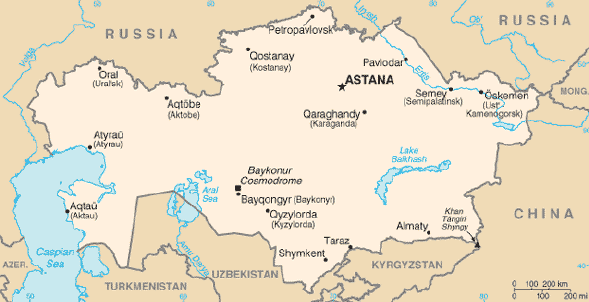| Kazakstan Table of Contents
With an area of about 2,717,300 square kilometers, Kazakstan is more than twice the combined size of the other four Central Asian states. The country borders Turkmenistan, Uzbekistan, and Kyrgyzstan to the south; Russia to the north; Russia and the Caspian Sea to the west; and China's Xinjiang Uygur Autonomous Region to the east.
There is considerable topographical variation within Kazakstan. The highest elevation, Khan Tengri Mountain, on the Kyrgyz border in the Tian Shan range, is 6,995 meters; the lowest point, at Karagiye, in the Caspian Depression in the west, is 132 meters below sea level (see fig. 2). Only 12.4 percent of Kazakstan is mountainous, with most of the mountains located in the Altay and Tian Shan ranges of the east and northeast, although the Ural Mountains extend southward from Russia into the northern part of west-central Kazakstan. Many of the peaks of the Altay and Tian Shan ranges are snow covered year-round, and their run-off is the source for most of Kazakstan's rivers and streams. Except for the Tobol, Ishim, and Irtysh rivers (the Kazak names for which are, respectively, Tobyl, Esil, and Ertis), portions of which flow through Kazakstan, all of Kazakstan's rivers and streams are part of landlocked systems. They either flow into isolated bodies of water such as the Caspian Sea or simply disappear into the steppes and deserts of central and southern Kazakstan. Many rivers, streams, and lakes are seasonal, evaporating in summer. The three largest bodies of water are Lake Balkhash, a partially fresh, partially saline lake in the east, near Almaty, and the Caspian and Aral seas, both of which lie partially within Kazakstan. Some 9.4 percent of Kazakstan's land is mixed prairie and forest or treeless prairie, primarily in the north or in the basin of the Ural River in the west. More than three-quarters of the country, including the entire west and most of the south, is either semidesert (33.2 percent) or desert (44 percent). The terrain in these regions is bare, eroded, broken uplands, with sand dunes in the Qizilqum (red sand; in the Russian form, Kyzylkum) and Moyunqum (in the Russian form, Moin Kum) deserts, which occupy south-central Kazakstan. Most of the country lies at between 200 and 300 meters above sea level, but Kazakstan's Caspian shore includes some of the lowest elevations on Earth. 
Custom Search
Source: U.S. Library of Congress |
